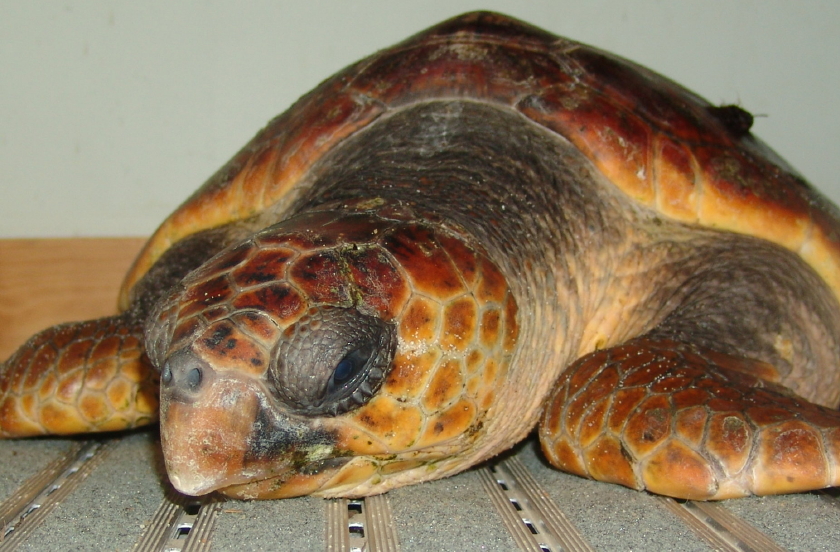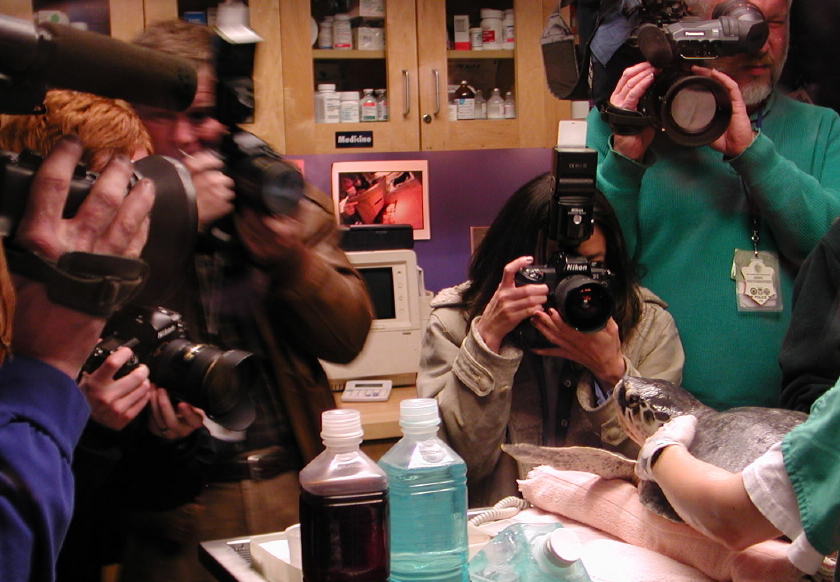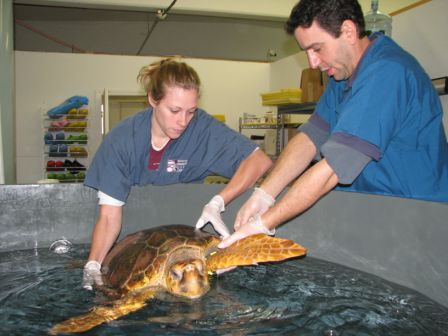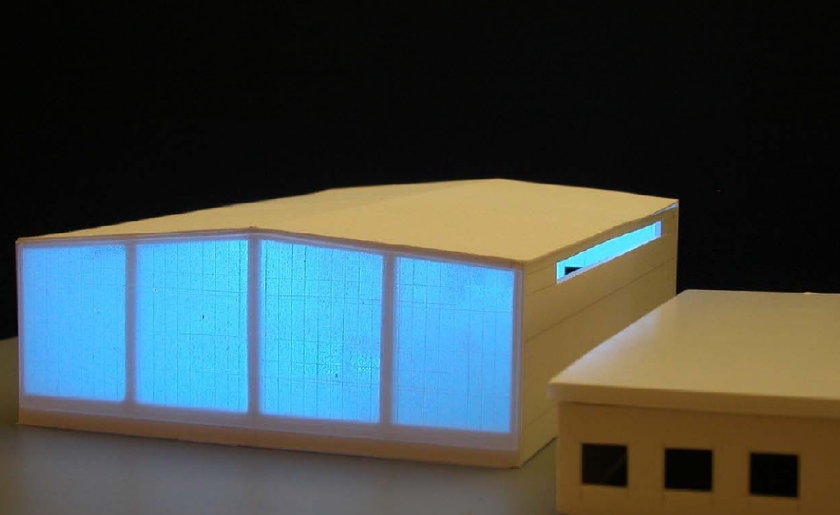Rescue >>>
        >> Triage >>>
                      >> Treatment >>>
                                          >> Rehab >>>
                                                       >> Release
Don Lewis Examines Lively Juvenile Loggerhead
When we last reported on sea turtle rescues in the Great White North, Turtle World Turned Upside Down, waves flash froze on frigid beaches and ocean water had transformed to icy slush within the intertidal zone. No sea turtle could survive those conditions when tossed ashore by coastal storms. In the interim, temperatures moderated, ice and slush melted, and live turtles once again have been recovered from Cape Cod beaches.Â
RESCUE
Click Here to View Video in High Quality
Sea Turtle Patrol of Truro Beaches at Sunset
Any search for cold-stunned sea turtles yields special moments as your mind constantly molds and shapes objects into patterns that may, or may not, represent a stranded animal. But no beach walk is as dramatic as a sunset or dawn patrol. When twice daily tides align so that the first high comes at sunrise, and the second at sunset, the experience transcends magical. In Disneyesque fashion, clumps of distant seaweed morph into turtles, then decompose back into seagrass as you approach. A gust of wind breathes life into debris that rises like a distressed seal, then deflates to become an abandoned buoy once again. It’s a smart game your brain plays to keep adrenaline levels high to ensure peak attention and focus. Otherwise, your thoughts would drift and your senses would become overwhelmed by pounding surf, howling winds, and miles and miles and miles of mind-numbing sameness.
Live, Cold-Stunned Kemp’s Ridley among Wrackline Debris
These mental gymnastics keep senses sharp and ready for immediate action when that clump of seaweed, shaped like a turtle, really is a stranded sea turtle in desperate need of rescue. Such was the case of this juvenile Kemp’s ridley overturned by the surf and deposited among piles of wrackline debris.
Juvenile Loggerhead Sea Turtle (Caretta caretta)
In Cape Cod, sea turtle strandings are driven by physics as much as biology. Obviously, ectothermic biology leads to cold-stunned stupor as these tropical and semi-tropical animals are beset by plunging water temperatures in the bay each fall. But once cold-stunning begins, biology surrenders to physics. Effects of the cold are felt earlier by less massive sea turtles. Smaller Kemp’s ridley strand earliest in the fall with larger and larger turtles coming ashore as the season progresses. Wind and sea drive these stunned turtles ashore, with less massive turtles easier to move than heavier animals. The result: ridleys first and loggerheads last.
We warm-blooded rescuers thank the gods of biology and physics for this blessing. We cut our teeth early in the season lugging five to ten pound ridleys along the beach, building muscles and endurance to be prepared for the 50, 75 and 100 pound loggerheads to come. About the time that the calendar flips from November to December, loggerheads begin to dominate the rescue scene … and our backs strain accordingly.
TRIAGE
Click Here to View Video in High Quality
Loggerhead & Ridley Turtles in Triage
After patrolling beaches, rescuers drop off cold-stunned sea turtles at Mass Audubon’s Wellfleet Bay Wildlife Sanctuary. In the triage center set up in the sanctuary’s wet lab, senior experts examine, evaluate and stabilize animals before transport to the New England Aquarium in Boston for medical treatment. By this time in the stranding season, more massive turtles have the better chance of survival, giving the edge to larger loggerheads over smaller ridleys.
Loggerhead Survived Earlier Shark Attack
This loggerhead with a large section of its left rear quadrant missing was a survivor of a probable shark attack. The wound and the shell had healed well. After beating 999-to-1 odds to reach juvenile stage, after surviving a shark attack in which a large chunk of its rear quadrant was lost, it seems a tragic shame that this turtle would succumb to hypothermia because of the accident of glacial geology that formed the giant seine net called Cape Cod.
Shark Attacked Loggerhead from 2000 Stranding Season
Eight years ago almost to the day, on 3 December 2000, a juvenile loggerhead was found on a Brewster beach. It, too, had survived a severe shark attack that had taken a huge piece of its right rear quadrant, including its right rear flipper.
Healed Shark Wound on Juvenile Loggerhead
The wound had healed so well and so long ago that a marine community had taken residence. You can make out the small blue mussels nestled along the edge of the chomped shell. Again, this loggerhead had survived a viscious shark attack only to succumb to cold-stunning in Cape Cod Bay. The story of this loggerhead can be found at Shark Attack!
Triage to Treatment
Click Here to View Video in High Quality
Kemp’s Ridleys and Loggerhead Go from Triage to Treatment
Once live turtles have been evaluated and prepared, volunteers drive them to the New England Aquarium in Boston for intensive medical treatment and to begin their rehabilitation. Kemp’s ridleys are small enough to fit in banana boxes donated by the local Stop & Shop in Orleans.  Inside these sturdy boxes, soften by donated fluffy towels, turtles can be contained safely during transport.Â
Loggerheads are “a whole ‘nother” story. They don’t really fit in banana boxes and even if they did, loggerheads are so rambunctious they might break through the sides. Many a night we would leave the sanctuary with a “comatose” loggerhead resting comfortably in triage drydock, only to find the room re-arranged in the morning by these powerful pelagic tanks. Several drivers have been forced to pull over during the long ride to Boston, because a loggerhead had decided to drive the rest of the way itself. When loggerheads get well enough for rehabilitation, they can never be kept in the same pool with another turtle of any species. Too aggressive. Each loggerhead has its own recovery pool … which brings us to the last, long leg of sea turtle rescues: rehabilitation.
Rehab
Click Here to View Video in High Quality
91-Pound Loggerhead in Rehab (2002)
(Story of This Rescue at The Big One That Didn’t Get Away)
After adventurous rescues from frigid Cape Cod beaches (RESCUE), after rigorous assessments and stabilization in triage at Mass Audubon’s Wellfleet Bay Wildlife Sanctuary (TRIAGE), after emergency medical treatment at the New England Aquarium in Boston (TREATMENT), the real heavy lifting begins (REHAB). For months, and on rare occasions even for years, these rescued turtles go through intensive rehabilitation.  Hospital-clean pools, daily medication, frequent examinations and x-rays, enrichment activities, and feeding, feeding, feeding, followed by cleaning, cleaning, cleaning. Medical care staff, sea water-equipped facilities, medical supplies, constant supervision, volunteers, and food, food, food.
Media Cover Sea Turtle Medical Treatment in Boston
Turtle rescuers often get public acclaim because scouring the beach on stormy nights sounds so risky and adventuresome. Triage receives news coverage because it’s the first time reporters can get visual access to these tragic looking critters for the morning edition. Emergency medical treatment in Boston steps into the limelight as metropolitan television stations and newspapers click pictures of high tech ER equipment and gowned personnel racing at “stat” pace. But rarely do cameras and journalists penetrate the daily grind of rehabilitation to document months of yeoman sacrifice to bring these animals full cycle from rescue to release.  Rehab personnel and centers are the unsung heroes of the sea turtle rescue process and Turtle Journal salutes them.
“Fletcher” Admitted to National Marine Life Center for Rehab
On Thursday, the National Marine Life Center — a key Cape Cod rehabilitation facility — admitted Fletcher, a juvenile loggerhead sea turtle that stranded at Fisher Beach in Truro on November 29th. Fletcher spent his first week in medical treatment at the New England Aquarium in Boston. He weighs 23.5 kilograms (~ 52 pounds) and measures just over two feet long. Active, alert and swimming well, he shows no visible signs of injury. Fletcher ate for the first time on Friday and received his first meds at NMLC. Welcome, Fletcher! And thank you, rehabilitators!
New National Marine Life Center Animal Hospital in Buzzards Bay
(NOTE: The National Marine Life Center will open the doors of its new marine animal hospital in Buzzards Bay this coming year. Stay tuned to Turtle Journal for progress reports on this exciting new “life raft” for marine critters in the Cape Cod area, a well known global stranding hot spot. For those who may be interested in supporting this exciting initiative to save marine animal lives in the Northeast, contact the NMLC at 508-743-9888 or email the NMLC Development Team.)









[…] These mental gymnastics keep senses sharp and ready for immediate action when that clump of seaweed, shaped like a turtle, really is a stranded sea turtle in desperate need of rescue . Such was the case of this juvenile Kemp’s ridley …[Continue Reading] […]
[…] Vote Loggerhead Days of December […]
[…] Vote Loggerhead Days of December […]
[…] We’ll also come face to face (virtually) with five species of threatened and endangered sea turtles that inhabit our bays and coastline. We’ll rescue a 900-pound entangled leatherback sea turtle trapped in lobster buoy lines in deep summer. We’ll patrol storm tossed beaches of Cape Cod Bay in the fall to rescue the most endangered sea turtle in the world, the Kemp’s ridley, as well as loggerheads and green sea turtles (see Loggerhead Days of December). […]
I like all the information you give about loggerhead rescue. It makes me want to volunteer! We have a sea turtle rescue section in Galveston but they are Kemp’s Ridleys sea turtles.